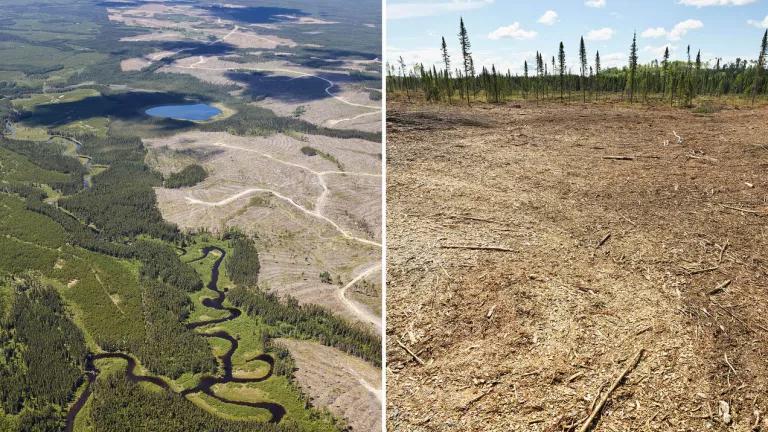Canada Invests in the Future of Intact Boreal Forests
With the announcement of a CAD $175 million commitment to fund 67 conservation initiatives, the Canadian government has invested in a more sustainable, healthier future by protecting some of its treasured landscapes, including in the boreal forest.

Canada has delivered on a promise that will benefit Canadians and people around the world for generations to come. With the announcement of a CAD $175 million commitment to fund 67 conservation initiatives, the Canadian government has invested in a more sustainable, healthier future by protecting some of its treasured landscapes, including in the boreal forest. As logging and other industrial development continue to chisel away at globally important intact boreal forests, this announcement takes a critical step toward protecting these forests for the benefit of all.
Despite its internationally lauded environmental reputation, Canada has lagged on its commitments to protect the boreal forest, along with its other wild places. Under the Convention on Biological Diversity (CBD), Canada pledged to safeguard 17 percent of its lands and inland waters by 2020. However, the country has been slow to act and, with less than 12 percent of its land safeguarded, it ranks last among G7 countries in proportion of its land it protects. With the clock ticking on the 2020 deadline, in its 2018 budget the Trudeau Government allocated an unprecedented $1.3 billion to nature conservation. Yesterday, the government announced that $175 million of this will go to fund conservation projects across every province and territory. While this won’t get Canada across the 17% finish line, it’s a promising start.
This announcement comes at a critical time. Globally, we are in the midst of the dual existential crises of biodiversity collapse and climate change. With two-thirds of the world’s forests degraded, protecting and restoring forests like the Canadian boreal—the largest intact forest left in the world—is essential to forestalling these crises before they reach fever pitch.
The boreal forest’s importance extends far beyond its value as a bucolic, Christmas card-esque landscape. It is habitat for iconic wildlife like the boreal caribou and pine marten and has been the home of Indigenous Peoples for millennia. It is also one of the most important buffers the world has against climate change, storing more than 12 percent of all terrestrial carbon on the planet in its soils, plants, and wetlands.
Yet, with so little of the boreal forest protected, logging, alongside mining and oil and gas development, has run roughshod over this ecologically important region. Every minute, Canadian logging companies clearcut an area of boreal forest the size of seven NHL hockey rinks. This logging is pushing boreal caribou and other species ever closer toward extinction and is eroding the ways of life of Indigenous Peoples. It’s also taking a tremendous toll on the global climate, releasing the vast amounts of carbon stored in the boreal into the atmosphere, just as the world is struggling to rein in emissions before it’s too late.
The Canadian government’s announcement starts to ease the logging industry’s stranglehold on the forest and set aside areas that it cannot touch.
With the threats to the boreal forest and other ecosystems so dire, protected areas need the highest-caliber care and stewardship possible. One of the most exciting aspects of this Nature Fund is that up to 27 of these initiatives will be launched and managed by Indigenous Peoples. Global studies have shown that, where Indigenous land rights are strong, both biodiversity and the climate benefit. Because of Indigenous Peoples’ unparalleled expertise in managing their lands, a 2018 from the Indigenous Circle of Experts, an advisory body for achieving Canada’s 17% commitment, identified the central role that “Indigenous knowledge, systems, legal traditions, and cultural practices” will play in reaching the CBD target.
Indigenous communities across the country submitted proposals—far more than are covered in this round of funding. From vast forest areas to small, ecologically rich pockets of land, the proposals serve as a compendium of the riches that need to be protected. The funded projects, on top of the recently announced funding for more Indigenous Guardians programs, will be a game-changer for both the environment and Indigenous rights to their territories. They also need to herald the funding of many, many more Indigenous Protected Areas.
Although the Canadian Government has taken a crucial step toward reclaiming its natural treasures from industry’s increasing carte-blanche with the future of Canada’s landscapes, there is still a lot of work to be done. Even after incorporating these new protected areas, Canada will likely still be well shy of its 17% commitment, which it now has only a year left to reach. As a central part of this effort, Canada needs to dramatically ramp up its investment in Indigenous Protected Areas. The demand is there, and the need dire. And 17% is just a milestone in a broader push to save and restore our intact ecosystems. Increasingly, scientists, NGOs, and communities have begun recognizing the need to broaden global ambition to protect 30 percent of the planet by 2030 to avert the worst of both the biodiversity and climate crises.
As 2020 approaches and countries look to define the next pivotal decade of nature protection, Canada has the opportunity to push for increased ambition globally and live up to its storied environmental reputation. The world needs a strong leader to shepherd in a new era of living within our planet’s means. Canada can be that leader, but there’s a lot more that needs to be done. Yesterday’s announcement, while cause for celebration, can’t be a stopping point: it’s just the beginning.




